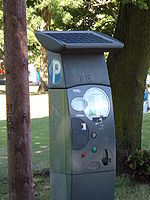
Stand-alone photovoltaic power system
Encyclopedia

Types
The two types of stand-alone photovoltaic power systems are direct-coupled system without batteries and stand alone system with batteries.Direct-coupled system
The basic model of a direct coupled system consists of a solar panel connected directly to a dc load. As there are no battery banks in this setup, energy is not stored and hence it is capable of powering common appliances like fans, pumps etc only during the day. MPPTs are generally used to efficiently utilize the Sun's energy especially for electrical loads like positive-displacement water pumps. Impedance matching is also considered as a design criteria in direct-coupled systems.Stand alone system with batteries
In stand-alone photovoltaic power systems, the electrical energy produced by the photovoltaic panels cannot always be used directly. As the demand from the load does not always equal the solar panel capacity, battery banks are generally used.The primary functions of a storage battery in a stand-alone PV system are:
- Energy Storage Capacity and Autonomy: To store energy when there is an excees is available and to provide it when required.
- Voltage and Current Stabilization: To provide stable current and voltage by eradicating transients.
- Supply Surge Currents: to provide surge currents to loads like motors when required.
System monitoring
Monitoring photovoltaic systems can provide useful information about their operation and what should be done to improve performance, but if the data are not reported properly, the effort is wasted. To be helpful, a monitoring report must provide information on the relevant aspects of the operation in terms that are easily understood by a third party. Appropriate performance parameters need to be selected, and their values consistently updated with each new issue of the report. In some cases it may be beneficial to monitor the performance of individual components in order to refine and improve system performance, or be alerted to loss of performance in time for preventative action. For example, monitoring battery charge/discharge profiles will signal when replacement is due before downtime from system failure is experienced.IEC standard 61724
IEC has provided a set of monitoring standards called the "Standard for Photovoltaic system performance monitoring". It focusses on the photovoltaic system's electrical performance and it does not address hybrids or prescribe a method for ensuring that performance assessments are equitable.Performance assessment

- Data collection, which is a straightforward process of measuring parameters.
- Evaluation of that data in a manner that provides useful information.
- Dissemination of useful information to the end user.
Load related problems
The wide range of load related problems identified are classified into the following types:- Wrong selection: Some loads cannot be used with stand-alone PV systems.
- House wiring: Inadequate or low quality wiring and protection devices can affect the system's response.
- Low efficiency: Low efficiency loads may increase energy consumption.
- Stand-by loads: Stand-by mode of some loads waste energy.
- Start-up: High current drawn by some loads during start-up Current spikes during the start-up can overload the system temporarily.
- Reactive power: The circulating current can differ from the current consumed when capacitive or inductive loads are used.
- Harmonic distortion: Non-linear loads may create distortion of the inverter waveform.
- Mismatch between load and inverter size: When a higher rated inverter is used for a lower capacity load, overall efficiency is reduced.
See also
- Grid-connected photovoltaic power systemGrid-connected photovoltaic power systemGrid-connected photovoltaic power systems are power systems energised by photovoltaic panels which are connected to the utility grid. Grid-connected photovoltaic power systems comprise of Photovoltaic panels, MPPT, solar inverters, power conditioning units and grid connection equipments. Unlike...
- List of rooftop photovoltaic installations
- Photovoltaic power plant
- Building-integrated photovoltaics
- Solar inverter
- Solar cableSolar cableSolar cable is the interconnection cable used in photovoltaic power generation. A solar cable interconnects solar panels and other electrical components in the photovoltaic system. Solar cables are designed to be UV resistant and weather resistant...
- Maximum power point trackerMaximum power point trackerMaximum power point tracking is a technique that grid tie inverters, solar battery chargers and similar devices use to get the maximum possible power from the PV array. Solar cells have a complex relationship between solar irradiation, temperature and total resistance that produces a non-linear...
- Solar trackerSolar trackerA solar tracker is a generic term used to describe devices that orient various payloads toward the sun. Payloads can be photovoltaic panels, reflectors, lenses or other optical devices....

